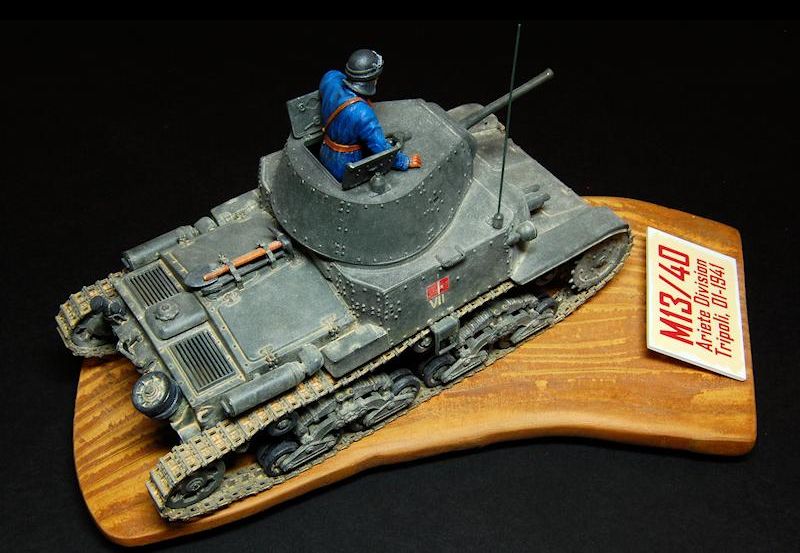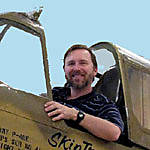1⁄35M13/40 Ariete Division, Tripoli 01-1941
3
Comments
Painting and markings
Construction complete, the whole thing was undercoated in white acrylic car primer. This is when I decided on the original Italian grey-green rather than the more usual desert yellow. The Italian Armoured Vehicles of World War Two book has a great colour photo from February 1941 of a recent M13 arrived in Libya, in this dark colour, with just a layer of dust over the suspension and the lower body. I tried to match this colour by mixing Tamiya XF-61 Dark Green and XF-69 NATO Black, with a small amount of X-3 Royal Blue; not too sure about the proportions, but the resulting colour was actually very similar to Revell enamel 40. Something a bit odd happened with the paint while in the airbrush: the colours started to separate and the colour became progressively more blue-grey. I tried to take advantage of this by keeping this bluer shade to the lower surfaces and completely avoided the turret. In the photo of the airbrushed model you can see this variation if you compare the sprocket to the turret [photo 15]. I quite like the effect even if it was partly accidental. Road wheel rims were painted with Lamp Black oil paint. This took ages to dry but it had the advantage that it only needed one coat and mistakes were very easily wiped off without damaging the acrylic base coat. This model was to represent the 1st vehicle, 1st platoon, 1st company of 7th battalion, so I decided (probably rashly) to paint all the markings except for the registration plates. Having missed the opportunity to mask off a section of undercoat to provide three white rectangles, I had to mask off all the green in order to paint them on top. Once dry, a central vertical line was masked and the red applied [photo 16]. Once the mask was removed, I kind of burnished the red paint over the edge of the white so that it didn’t show around the edges under the red; the only problem is that it stands a little proud of the surface, although this effect was reduced slightly once a coat of Klear was applied. Again, this defect is the result of a lack of proper planning in my part… The battalion number “VII” below was hand painted between two horizontal pieces of masking tape in order to keep the edges square and the size consistent. A rear registration decal from the kit was used and applied to a piece of plastic card rather than straight on to the hull, as the original would have been a stamped metal plate. I also, mistakenly, applied the front registration decal; I realised afterwards that the front registration number was only used after the middle of 1941 so wouldn’t have applied to my vehicle. In any case the front registration plate decal is too big to fit correctly between the rivets at the top of the nose and the central towing eye as all illustrations and photos show it should. As a result mine overlaps the top of the towing eye a little; it was fixed with Micro-sol, and is actually partially covered by the tow rope. Note that Model Victoria also supply M-series decals which would provide options beyond those supplied in the kit and the front plates may be more accurately sized. The tracks were primed in grey, then brush painted with a well-thinned but only semi-blended mixture of Humbrol M29 Dark Earth and M67 Tank Grey. The prominent tread and guide teeth were dry brushed with Windsor & Newton Pewter oil paint; this was also done sparingly to the sprocket teeth. The tracks were then fitted [photo 17]. Note in this photo the very shiny coating of Klear.Weathering
This is meant to be a fairly new vehicle that has yet to see any action but which is now in a dusty environment. I used the dot filter technique to provide light discolouration, and the effect was applied gradually more sparingly as I worked upwards, so that the suspension area received quite a lot, the turret less. The colours for this were mainly Yellow Ochre and Rowney Flesh Tint; this may sound weird, and I wouldn’t have used the very rose pink Windsor & Newton flesh for this, but the Rowney Flesh has a slightly pink to very pale brown hue which I think is good for North Africa (OK, I’ve not been to Libya, but Morocco was a very nice holiday!) In a couple of places on the turret blue was also used. A thin wash mix of mainly Flesh with some Ochre was then applied to the suspension and hull to give the effect of dust having collected around edges; a slightly thicker mix was daubed into the tracks. This effect was added to by dry brushing with the same two oil colours, this time including, but very lightly, the turret; for this the colours were only semi-mixed so that the proportion varied as it was used. Finally pastel chalks, ground to dust then worked in with a very small brush: a pink-brown to add dusty highlights to the tops of many of the rivets, and black to add a bit of definition under some rivets and around those edges which I deemed non-dust-traps. Some weeks later I came back to it and increased the amount of dust on the vehicle generally, having decided that it was just a bit too subtle.Comments
Very enjoyable read Matthew, and nice job on the diminutive M13/40. The AM tracks were well worth it, IMO. Bannerman's book must be very good, or you're a natural figure painter, as your commander came out extremely well...and both eyes look perfect to me! Thanks for sharing this one.
OCT 09, 2012 - 09:14 AM
Matthew,
Your M13/40 is well built and looks like it's put dozens of dust miles under its tracks. Well done!
I concur with James, your commander looks very convincing.
OCT 10, 2012 - 03:11 PM
Hello, I am writing from Italy and I like the WWII African war. The "M13/40 II serie" you have build is o good subject, but a first sight you have made two errors: the front plate because the second serie has not and the number of plate because the VII battalion had number between 3002- 3030 approximately. Finally the "cupolotto" on the radiator, smooth and without the upper fins for cooling as you can say from your photo for inspiration. Write to me for other request if you want...
SEP 16, 2016 - 12:47 AM
Copyright ©2021 by Matthew Lenton. Images and/or videos also by copyright holder unless otherwise noted. The views and opinions expressed herein are solely the views and opinions of the authors and/or contributors to this Web site and do not necessarily represent the views and/or opinions of Armorama, KitMaker Network, or Silver Star Enterrpises. All rights reserved. Originally published on: 2012-10-08 00:00:00. Unique Reads: 17349

























